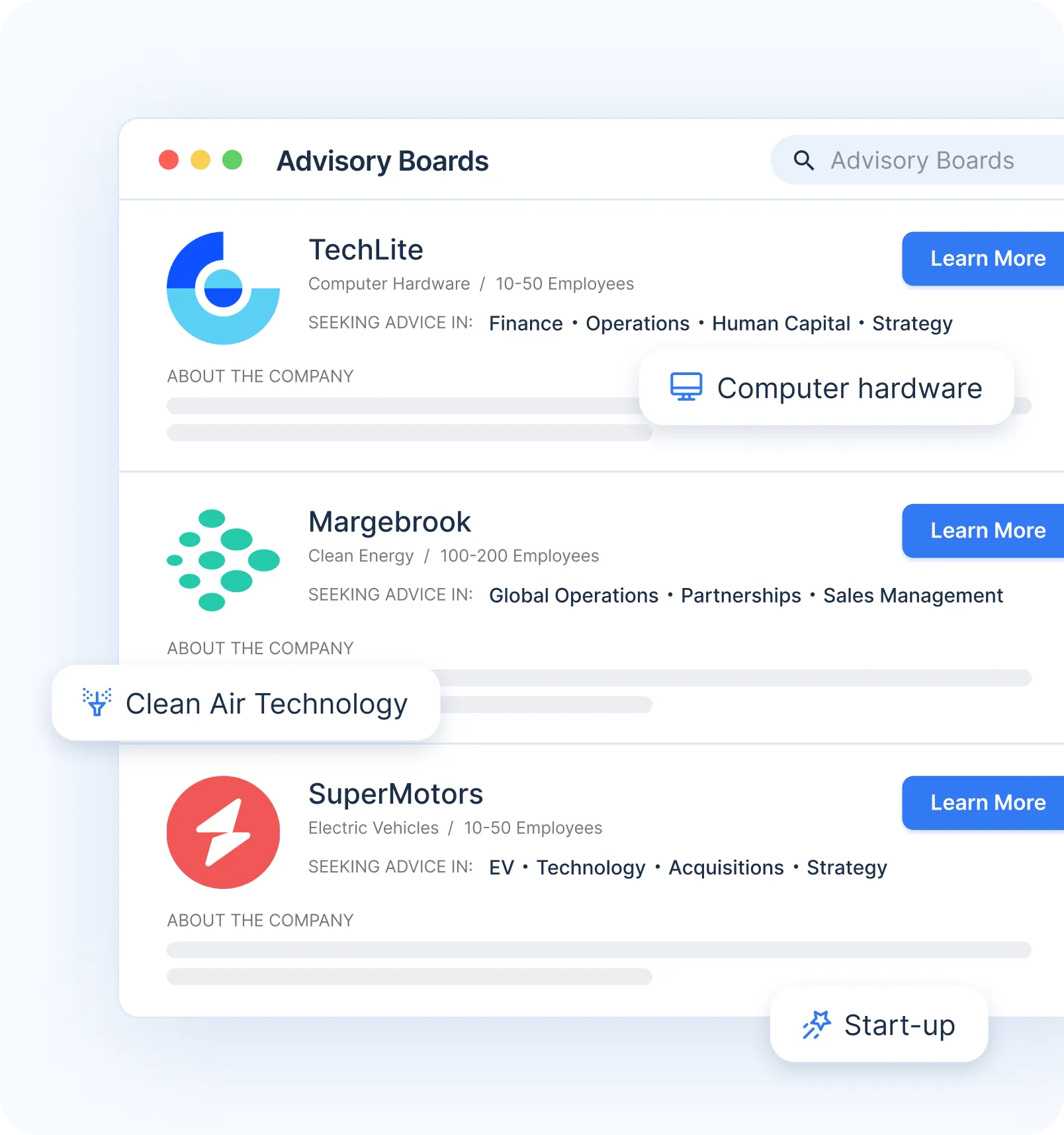May 17, 2023

How to Improve Your Leadership Skills as a VP of Information Systems
As a Vice President (VP) of Information Systems, you hold a critical position in your organization. You are responsible for managing the crucial technological needs of your company, ensuring that they align with overall business goals. However, the role also demands strong leadership skills, including the ability to manage and motivate a team, communicate effectively, make informed decisions, and foster innovation.
Understanding the Role of a VP of Information Systems
As a VP of Information Systems, you play a vital role in the success of your organization. Your responsibilities go beyond just managing the IT infrastructure. You are responsible for developing and overseeing the IT strategy, leading a team of IT professionals, and collaborating with other departments to identify and prioritize technological needs based on business objectives.
It's essential to understand the demands and expectations of your role before delving into how you can improve your leadership skills. Here are some of the key responsibilities you can expect:
- Developing and overseeing the IT strategy of the organization: You will be responsible for creating a roadmap that aligns with the company's overall objectives. This requires a deep understanding of the company's operations and objectives.
- Ensuring that the IT infrastructure is reliable, efficient, and secure: You will be responsible for maintaining the IT infrastructure to ensure that it is reliable, efficient, and secure. This includes managing risks, controlling costs, and ensuring that projects are delivered on time and within budget.
- Leading a team of IT professionals and overseeing their development and performance: Your team is the backbone of your IT function. Hiring the right talent, empowering your team, providing them with ongoing feedback, coaching, and development opportunities are critical to their success.
- Collaborating with other departments to identify and prioritize technological needs based on business objectives: You will need to work closely with other departments to identify their unique needs and requirements. This will help you align IT efforts with overall business objectives to ensure that IT is an integral part of the company's growth and success.
Key Responsibilities and Expectations
Managing the expectations of stakeholders while ensuring that you meet the demands of your role is one of the biggest challenges of being a VP of Information Systems. Here are some key responsibilities to keep in mind:
- Establish clear goals that align with your company's overall objectives: Setting clear goals is critical to achieving success. Make sure your goals align with the company's overall objectives.
- Identify the resources and support you need to achieve those goals, including budget, talent, and infrastructure: Identifying the resources and support you need is critical to achieving your goals. Make sure you have the budget, talent, and infrastructure to support your IT strategy.
- Communicate effectively with stakeholders, including executives, board members, and departmental leaders: Communication is key to managing expectations. Make sure you communicate effectively with stakeholders, including executives, board members, and departmental leaders.
- Manage risks, control costs, and ensure that projects are delivered on time and within budget: Managing risks, controlling costs, and delivering projects on time and within budget are essential to the success of your IT function.
Aligning IT Strategy with Business Goals
Ensuring that the IT strategy aligns with the business's overall goals is one of the most critical responsibilities of a VP of Information Systems. Here are some tips to help you align your IT strategy with business goals:
- Create short-term and long-term IT roadmaps that support company goals: Creating short-term and long-term IT roadmaps that support company goals is critical to aligning IT efforts with overall business objectives.
- Communicate the IT strategy and roadmap to stakeholders and ensure that there is buy-in from all relevant departments: Communicating the IT strategy and roadmap to stakeholders and ensuring that there is buy-in from all relevant departments is essential to achieving success.
- Collaborate with other departments to identify their unique needs and requirements: Collaborating with other departments to identify their unique needs and requirements will help you align IT efforts with overall business objectives.
- Align IT efforts with overall business objectives to ensure that IT is an integral part of the company's growth and success: Aligning IT efforts with overall business objectives is critical to ensuring that IT is an integral part of the company's growth and success.
Managing and Developing Your Team
Your team is the backbone of your IT function. Here are some tips to help you manage and develop your team:
- Hire the right talent with the necessary skills and experience: Hiring the right talent with the necessary skills and experience is critical to the success of your IT function.
- Empower your team by giving them the resources, support, and autonomy they need to succeed: Empowering your team by giving them the resources, support, and autonomy they need to succeed is critical to their success.
- Provide your team with ongoing feedback, coaching, and development opportunities to ensure that they are growing professionally: Providing your team with ongoing feedback, coaching, and development opportunities is critical to ensuring that they are growing professionally.
- Encourage collaboration and communication within your team to foster a culture of innovation and creativity: Encouraging collaboration and communication within your team is critical to fostering a culture of innovation and creativity.
Developing Effective Communication Skills
As a leader, your ability to communicate effectively is essential. Whether you are presenting your vision and strategy to stakeholders or providing feedback to your team, communication skills are critical. Effective communication can help you build strong relationships, enhance collaboration, and achieve your goals. Here are some tips to enhance your communication abilities:
Active Listening and Empathy
Communication is a two-way street. To be an effective communicator, you must be an active listener. This means being fully present and attentive to the speaker, asking clarifying questions, and responding appropriately. When you listen actively, you can better understand the needs and concerns of others. Empathy is also crucial. When you put yourself in the shoes of the person you are communicating with, you can better understand their perspective and needs. This can help you build stronger relationships and enhance collaboration.
Articulating Your Vision and Strategy
As a VP of Information Systems, your vision and strategy are essential components of your role. Communicating them clearly is crucial to ensure that stakeholders understand your direction and support your initiatives. Here are some tips for articulating your vision and strategy effectively:
- Understand your audience and tailor your message to their needs and preferences. When you understand your audience, you can better communicate your message in a way that resonates with them.
- Use clear and concise language, avoiding jargon and technical terms that may confuse your audience. When you use simple, easy-to-understand language, you can ensure that your message is clear and accessible.
- Be confident in your delivery and use evidence and examples to support your messaging. When you are confident in your message and use evidence to support it, you can build credibility and inspire confidence in your stakeholders.
Building Trust and Collaboration
Building trust and collaboration with stakeholders is crucial for your success. Here are some tips to help you build strong relationships:
- Be transparent and honest in all your communications. When you are transparent and honest, you can build trust and credibility with your stakeholders.
- Show a genuine interest in the ideas and concerns of others. When you show a genuine interest in the ideas and concerns of others, you can build stronger relationships and enhance collaboration.
- Be open to feedback and willing to make changes based on it. When you are open to feedback and willing to make changes based on it, you can demonstrate your commitment to continuous improvement and build trust with your stakeholders.
- Collaborate with stakeholders, making them feel that they are an integral part of the process. When you collaborate with stakeholders, you can build stronger relationships and enhance collaboration.
By developing effective communication skills, you can build strong relationships, enhance collaboration, and achieve your goals. Remember to actively listen, show empathy, articulate your vision and strategy clearly, and build trust and collaboration with your stakeholders.
Enhancing Decision-Making Abilities
As a VP of Information Systems, you will be required to make tough decisions regularly. Here are some tips to enhance your decision-making abilities:
Gathering and Analyzing Data
Data is an invaluable resource in decision-making. To make informed choices, you need accurate and timely data. Here are some tips to help you gather and analyze data effectively:
First, it is important to understand your data requirements. Once you have identified what data you need, gather it from reliable sources. This will ensure that your data is accurate and up-to-date.
Next, use data visualization tools to make sense of complex data sets. Data visualization tools can help you identify patterns and trends that may not be immediately apparent when looking at raw data.
It is also a good idea to collaborate with other departments to gather relevant information and gain multiple perspectives. This can help you make more informed decisions and avoid potential blind spots.
Balancing Short-Term and Long-Term Goals
As a VP of Information Systems, you need to balance short-term and long-term goals. Short-term goals are essential for achieving immediate results, while long-term goals are essential for creating sustainable growth. Here are some tips for balancing them effectively:
First, identify the IT projects and initiatives that align with both short-term and long-term goals. This will help you prioritize your efforts and ensure that you are working towards both immediate and long-term goals.
Breaking down long-term goals into smaller milestones that can be achieved over time can also help you balance short-term and long-term goals. This approach allows you to make progress towards long-term goals while still achieving short-term wins.
Finally, set realistic timelines and budgets for short-term and long-term initiatives. This will help you avoid over-committing resources and ensure that you are making steady progress towards your goals.
Managing Risk and Uncertainty
Uncertainty and risk are inherent in any decision-making process. Here are some tips to help you manage risk and uncertainty:
First, identify potential risks and their likelihood and impact. This will help you prioritize your efforts and focus on the risks that are most likely to have a significant impact on your projects.
Collaborating with other departments to identify potential risks and develop mitigation strategies can also help you manage risk and uncertainty. This approach can help you identify blind spots and ensure that you are taking a comprehensive approach to risk management.
Finally, be prepared to adapt to changing circumstances and adjust your plans accordingly. This will help you stay nimble and respond quickly to unexpected challenges or opportunities.
Fostering a Culture of Innovation
A culture of innovation is essential for staying ahead in today's ever-changing business landscape. As a leader, you play a critical role in fostering innovation. Here are some tips to help you create an environment that supports innovation:
Encouraging Creativity and Experimentation
Creativity and experimentation are at the heart of innovation. Here are some ways that you can encourage creativity and experimentation within your team:
- Allow your team to experiment with different approaches and solutions.
- Encourage brainstorming, ideation, and open discussion.
- Provide resources and support for team members' ideas and projects.
Implementing Continuous Learning and Improvement
Continuous learning and improvement are essential for staying ahead in today's fast-paced business environment. Here are some tips to help you implement a culture of continuous learning and improvement:
- Encourage your team to pursue ongoing training and development opportunities.
- Provide opportunities for your team to learn from their experiences, both successes and failures.
- Celebrate successes and recognize team members for their achievements.
Recognizing and Rewarding Success
Finally, recognizing and rewarding success is essential for fostering a culture of innovation. Here are some tips to help you recognize and reward success within your team:
- Celebrate team successes publicly, highlighting the contribution of individual team members.
- Provide meaningful rewards, such as bonuses or promotions, for exceptional performance.
- Show your appreciation for the hard work and dedication of your team members.
ConclusionBecoming a successful VP of Information Systems requires a combination of technical expertise and leadership skills. By understanding your role, aligning your IT strategy with business objectives, managing your team effectively, communicating clearly and effectively, making informed decisions, and fostering a culture of innovation, you can improve your leadership skills and drive success within your organization.
Here's the HTML list:
- What is the role of a VP of Information Systems?
- What are some key responsibilities of a VP of Information Systems?
- What are some tips for aligning IT strategy with business goals?
- What are some tips for developing effective communication skills as a VP of Information Systems?
- How can a VP of Information Systems foster a culture of innovation?
See what boards you match with.
See what you qualify for with our 2-minute assessment.


Similar Articles

August 20, 2025
What are the perks of being a board member?
August 20, 2025
The 5 Key Benefits to Being an Advisor
August 20, 2025
Should I list my advisory roles for startups on my resume?
August 20, 2025
Remote Advisory Work - The Job That Works on Your Schedule
August 20, 2025
Mark Zuckerberg's Top 5 Secrets to Success
August 20, 2025
Invest In Your Career With These 5 Opportunities
August 20, 2025
How to know if you’re ready to be a board member.
August 20, 2025
How to Improve Your Time Management Skills as a VP of Sales
August 20, 2025
How to Improve Your Time Management Skills as a VP of Data
August 20, 2025
How to Improve Your Technical Skills as a VP of Technology
August 20, 2025
How to Improve Your Technical Skills as a VP of Supply Chain
August 20, 2025
How to Improve Your Technical Skills as a VP of Strategy
August 20, 2025
How to Improve Your Technical Skills as a VP of Security
August 20, 2025
How to Improve Your Technical Skills as a VP of Sales
August 20, 2025
How to Improve Your Technical Skills as a VP of Procurement
August 20, 2025
How to Improve Your Technical Skills as a VP of Operations
August 20, 2025
How to Improve Your Technical Skills as a VP of Marketing
August 20, 2025
How to Improve Your Technical Skills as a VP of Innovation
August 20, 2025
How to Improve Your Technical Skills as a VP of Finance
August 20, 2025
How to Improve Your Technical Skills as a VP of E-Commerce
August 20, 2025
How to Improve Your Technical Skills as a VP of Digital
August 20, 2025
How to Improve Your Technical Skills as a VP of Data
August 20, 2025
How to Improve Your Technical Skills as a VP of Compliance
August 20, 2025
How to Improve Your Technical Skills as a General Counsel
August 20, 2025
How to Improve Your Technical Skills as a Chief Risk Officer
August 20, 2025
How to Improve Your Technical Skills as a Chief Data Officer











































































